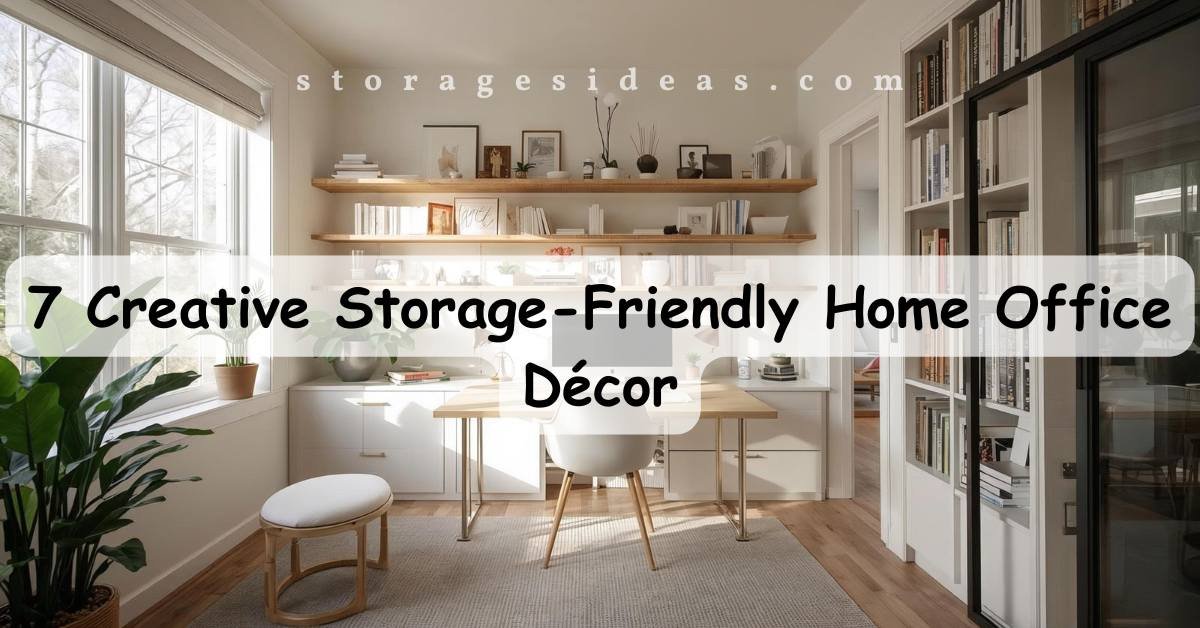When I started working from home full-time, my workspace gradually transformed into a cluttered nest of notebooks, stray cables, and unidentifiable pens. I’d sit down, stare at the chaos, and lose ten minutes just looking for a charger. That’s when I decided to take storage seriously, but on my terms.
I wanted solutions that were useful and beautiful. The result: a room that works for me.
This guide shares seven practical, design-forward ideas that helped me transform a cluttered corner into a calm, productive workspace.
Each idea is rooted in real use, not just photo-ready staging, so you can recreate them without a full remodel. If you want storage that blends with your décor and supports your day, these concepts will help you get there. Think of this as a playbook for Storage Friendly Home Office Décor that actually fits real life.
In This Guide, I’ll Cover
Toggle1. Vertical Storage That Clears the Floor (Floating Shelves & Wall Units)
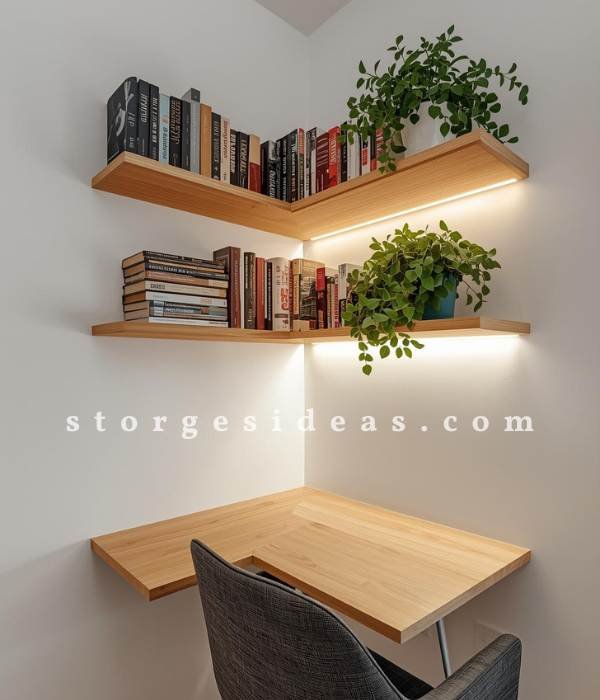
Small rooms feel smaller when the floor’s crowded. I learned that the quickest way to liberate a space was to look up. Floating shelves and slim wall units gave me storage without stealing floor area, and they instantly changed the room’s proportions.
I installed solid wooden floating shelves using concealed brackets; they appear to hover, which keeps the visual weight light. One shelf holds essential reference books and a couple of decorative items; another stores small boxes with chargers, sticky notes, and receipts. Using both open and closed containers helps me keep the shelf useful without looking overloaded.
A tip that always works for me: use shelves to define zones. I have one shelf directly above my desk for daily tools and a higher shelf closer to the door for decorative objects. That separation marks a subtle boundary between work and circulation space, which helps the room stay tidy even on busy days.
If drilling is an issue, consider narrow book rails or wall-mounted magazine files, which produce the same upward pull. For added comfort during evening work sessions, I mounted a warm LED strip beneath the lowest shelf. The glow doubles as task lighting and mood lighting, turning functional storage into a soft design element that pairs beautifully with the ideas from 15 Simple New Year Home Decoration Ideas.
2. Furniture That Works Double Duty (Desks + Hidden Storage)
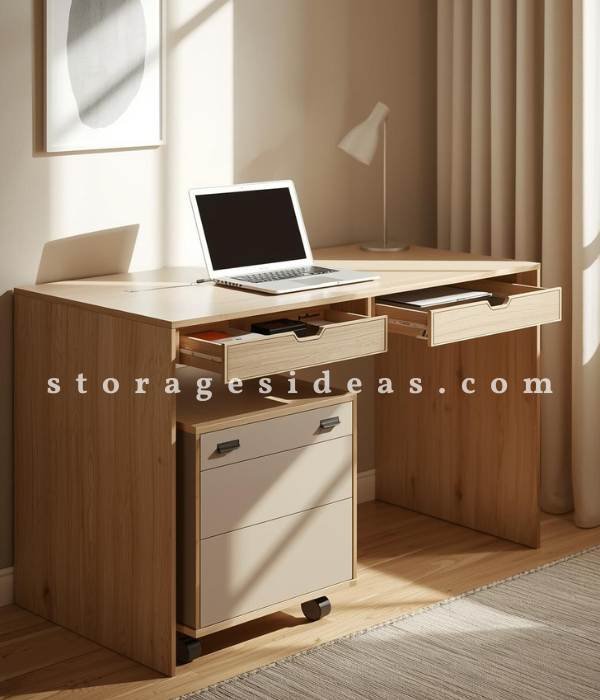
My next move was to stop letting my desk be a drop zone. I traded a plain table for a desk with integrated storage drawers, a lift-top compartment, and a sliding cabinet on casters. The difference was immediate: papers went into designated drawers, chargers had a home, and the top looked intentionally minimal.
I have a small hidden compartment beneath the desktop where I keep current project folders, pens, and a charging puck. When I close the lid, the desktop reads as clean. When I open it, everything is within reach. Then there’s the rolling cabinet tucked under the desk that slides out when I need it and disappears when I don’t. It even doubles as a guest seat with a cushion on top.
Look for desks with built-in cable passes, a charging station, or a fold-away keyboard tray to reduce desktop clutter. Hybrid pieces like benches with storage or filing cabinets that double as side tables give your room flexibility without sacrificing style. For me, investing in smart furniture shrank daily friction: less time searching, more time doing.
And yes, accept that one drawer will become a “mystery zone.” Label it, embrace it, move on. The functional-meets-design approach fits perfectly with the principles outlined in 15 Cozy Winter Living Room Décor Ideas.
3. Hidden Storage Behind Stylish Facades
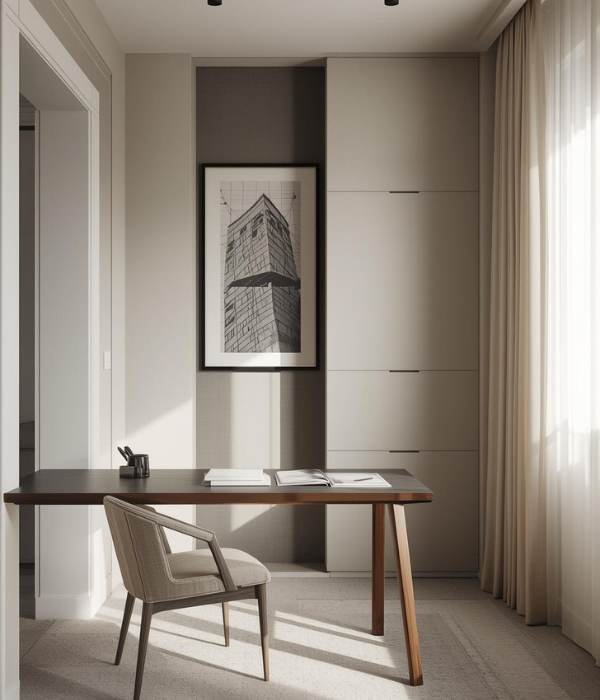
There’s a kind of magic in storage that hides in plain sight. I repurposed a large framed canvas into a shallow storage door. It swings open to reveal a slim compartment for mail, notebooks, and the tangle of cables I don’t want on display. From the outside, it’s art; on the inside, it’s practical.
If built-in modifications aren’t possible, magnetic cork panels covered in fabric are a low-cost alternative. I covered mine in linen and keep receipts and reminders tucked behind it looks intentional and keeps my surfaces clear. Mirrors, large clocks, and framed panels can also conceal storage if you convert them into shallow cabinets.
For renters, freestanding room dividers with built-in pockets are a smart option. They create privacy for video calls while hiding supplies. The underlying trick is to make the concealment part of the décor so the room feels cohesive rather than camouflaged.
The psychological payoff is notable: knowing things are put away but still accessible gives you a sense of control. That calm matters more than you’d expect, especially in flexible homes like those featured in 9 Minimalist January Home Styling Ideas.
4. Flexible Storage Units That Move With You
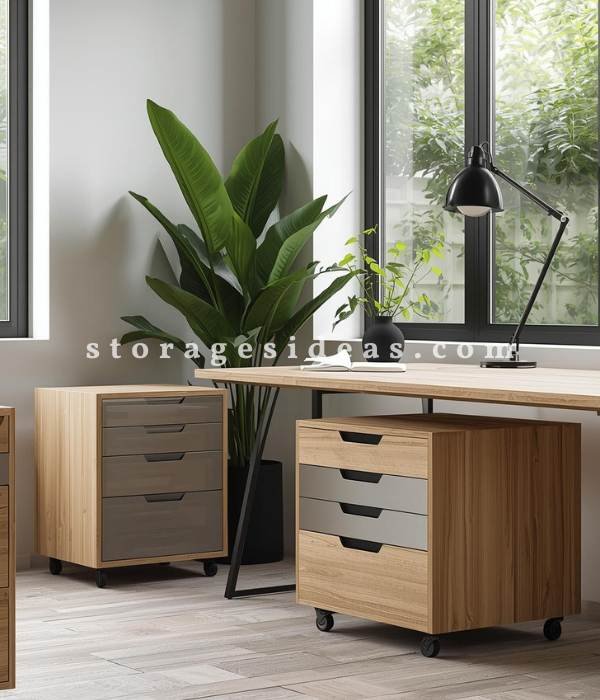
I rearrange my workspace a lot. Some days I need a bright corner to spark creativity; other days I want to face the window. Static storage made that frustrating. So I switched to modular, mobile units on casters, stackable cubes, rolling drawer carts, and small trolleys.
These units live under the desk during busy weeks and roll into a reading nook on weekends. Because they’re finished to match my furniture, they never look like odd bits of office furniture; they look intentional wherever they sit. I have one slim cart reserved for art and brainstorming supplies; on lazy Saturdays it joins me in the living room.
If you share a workspace, mobile storage becomes a personal locker: everyone can have a drawer or cube that moves and tucks away. When shopping, choose casters with locks, so your storage stays put when it should.
Mobile systems also let you adapt to seasons: roll storage near a sunny window in summer, move it closer to heating in winter. The flexibility keeps the space functional and fresh, which keeps me from feeling pinned down by my own setup — a trend that aligns perfectly with the evolving layouts described in 20 Interior Design Trends 2025 – Decorilla.
5. Pegboards & Vertical Wall Systems That Add Personality
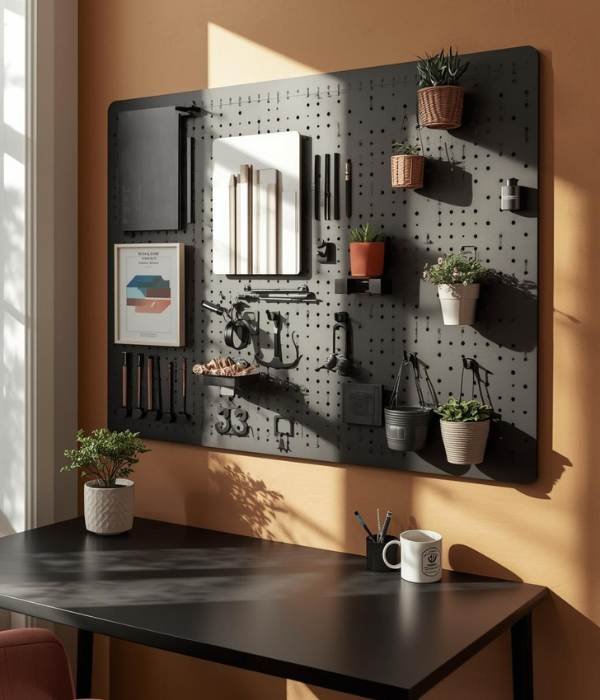
I used to think pegboards belonged in the garage. Then I painted one to match my wall and turned it into an organizing feature. Now it holds my headphones, scissors, a small clip board for daily tasks, and a few inspiring postcards.
Pegboards are brilliant because they turn vertical surfaces into living systems. I change the layout depending on projects, sometimes tools, sometimes inspiration. A slim shelf underneath creates a layered look that reads like design, not utility. Hooks, baskets, and trays let you keep frequently used items reachable while keeping the desktop clear.
Choose hardware finishes that match your overall palette: matte black for modern, brass for warmer tones, or natural wood pegs for softer looks. Backlighting the pegboard with narrow LED strips adds depth and helps the display read as intentional décor.
This system keeps me accountable: everything has a place, and the visual order nudges me to return items after use.
6. Transform Awkward Corners into Hidden Storage Zones
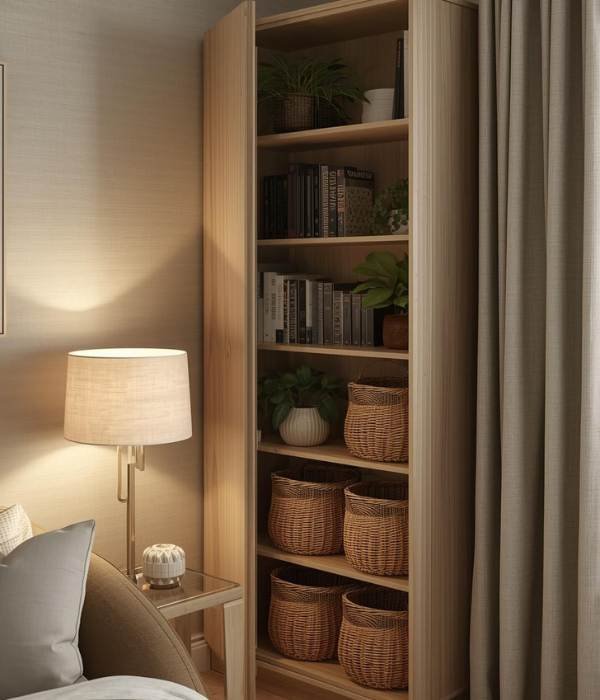
That awkward corner that used to gather dust became a focal point after I installed a tall curved shelving unit. The lower shelves hold baskets for documents and tech supplies; the upper shelves display plants and small artwork.
It turned a dead spot into a calm, functional niche.
If space is tight, try triangular shelving, narrow corner desks, or behind-the-door organizers. I use a slim over-the-door rack for shipping supplies and spare notebooks. The difference between a neglected corner and a useful one often comes down to scale. Choose narrow, vertical pieces that respect the footprint.
Lighting makes corners cozy. A small lamp or an LED uplighter draws the eye and turns the nook into an intentional pause point. Mixing materials (metal shelves beside a wooden desk) adds visual interest and keeps the arrangement from feeling too matchy.
Now, when I need a moment away from the screen, my eyes settle on that corner. It’s a built-in mental reset that I didn’t know I needed.
7. Stylish Containers Because Organized Doesn’t Have to Mean Boring
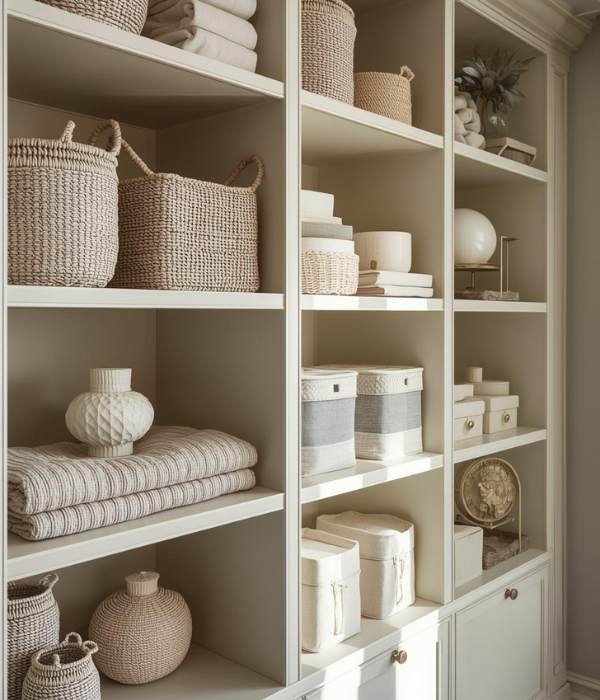
Visible storage can be beautiful. I swapped mismatched plastic bins for woven baskets, linen boxes, and suede containers. These pieces add texture and warmth, and when grouped with a consistent palette they make storage feel like décor.
I sort by function: large baskets for bulky items, medium boxes for documents, small containers for cables and chargers. Minimal adhesive labels keep things findable without spoiling the look. I also stacked a few linen boxes to double as a side table for my coffee. People think it’s intentional, and it is (mostly).
Switch materials seasonally seagrass in summer, felt in winter, to refresh the mood without a redesign. On open shelves I balance these containers with personal items like a ceramic vase or a framed photo so the arrangement feels lived-in, not staged.
Good containers do more than hide stuff; they add a finishing layer to the room that makes the whole space feel considered, a philosophy echoed in 2025 Home Design Trends That Are In or Out – Better Homes & Gardens.
Design & Layout Tips I Use Daily
Making storage work requires a few everyday habits:
Designate a place for everything. I assign homes to chargers, pens, and notebooks so I don’t have to hunt.
End-of-day reset. I spend 60 seconds clearing my desktop before I log off. It’s a small ritual that saves time the next morning.
Balance display and stow. I keep roughly 60% of my shelves for display and 40% for hidden storage, enough personality, enough function.
Use warm lighting. Accent lights under shelves or behind pegboards make storage feel intentional rather than purely utilitarian.
Label discreetly. Simple, minimalist labels prevent rummaging and preserve the aesthetic.
These habits, combined with the right furniture and wall systems, keep my workspace functional and calming.
Conclusion
Turning my messy corner into a place I actually want to work wasn’t about a one-time cleanup. It was a design shift, treating storage as a core part of décor rather than an afterthought. With a few key moves, vertical shelves, clever furniture, hidden cabinets, mobile units, pegboards, corners reimagined, and stylish containers, I created a space that supports how I work and how I live.
If you’re aiming for Storage Friendly Home Office Décor, start small. Add a floating shelf, try a rolling drawer, or swap a plastic bin for a woven basket. Each step makes your workspace easier to use and nicer to be in. For me, that calm showed up in my work: fewer distractions, clearer thinking, and a room that feels genuinely mine.
When I step into my office now, I feel lighter. The desk is ready, the shelves tell a story, and the storage finally works with me instead of against me. That’s the kind of change that makes a real difference.

